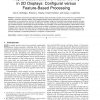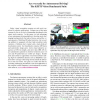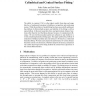327 search results - page 55 / 66 » Disambiguating the recognition of 3D objects |
TOH
2010
13 years 8 months ago
2010
—Participants learned through feedback to haptically classify the identity of upright versus inverted versus scrambled faces depicted in simple 2D raised-line displays. We invest...
CVPR
2012
IEEE
12 years 2 days ago
2012
IEEE
Today, visual recognition systems are still rarely employed in robotics applications. Perhaps one of the main reasons for this is the lack of demanding benchmarks that mimic such ...
AMFG
2003
IEEE
14 years 2 months ago
2003
IEEE
Recognition under illumination variations is a challenging problem. The key is to successfully separate the illumination source from the observed appearance. Once separated, what ...
BMVC
2001
14 years 1 days ago
2001
The ability to construct CAD or other object models from edge and range data has a fundamental meaning in building a recognition and positioning system. While the problem of model...
CVPR
2007
IEEE
14 years 11 months ago
2007
IEEE
This paper addresses the problem of markerless tracking of a human in full 3D with a high-dimensional (29D) body model. Most work in this area has been focused on achieving accura...



